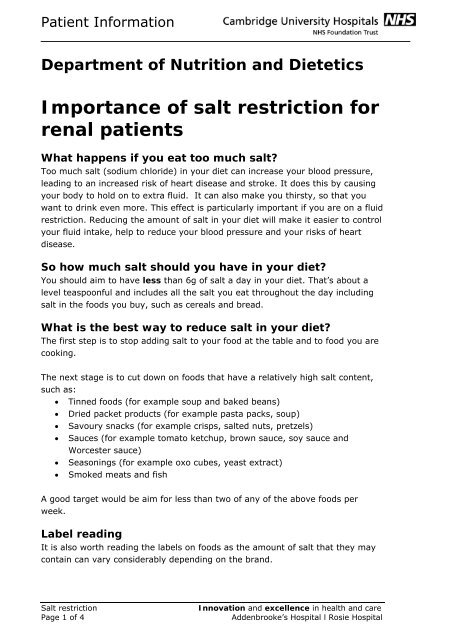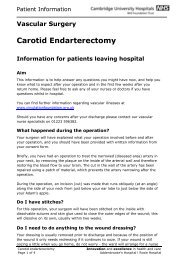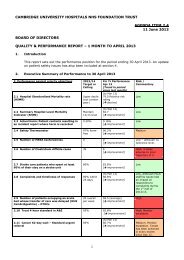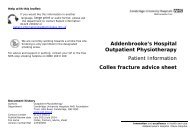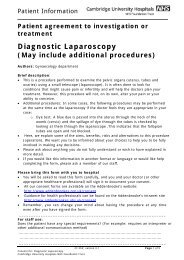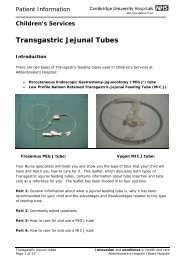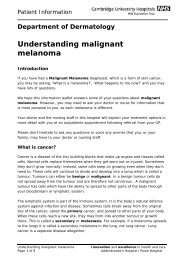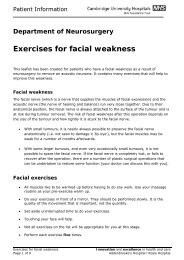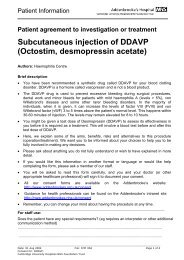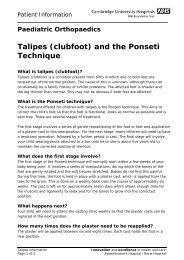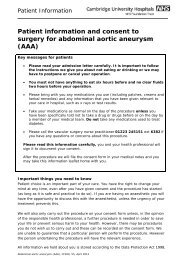Importance of salt restriction for renal patients - Cambridge ...
Importance of salt restriction for renal patients - Cambridge ...
Importance of salt restriction for renal patients - Cambridge ...
Create successful ePaper yourself
Turn your PDF publications into a flip-book with our unique Google optimized e-Paper software.
Patient In<strong>for</strong>mation<br />
Department <strong>of</strong> Nutrition and Dietetics<br />
<strong>Importance</strong> <strong>of</strong> <strong>salt</strong> <strong>restriction</strong> <strong>for</strong><br />
<strong>renal</strong> <strong>patients</strong><br />
What happens if you eat too much <strong>salt</strong>?<br />
Too much <strong>salt</strong> (sodium chloride) in your diet can increase your blood pressure,<br />
leading to an increased risk <strong>of</strong> heart disease and stroke. It does this by causing<br />
your body to hold on to extra fluid. It can also make you thirsty, so that you<br />
want to drink even more. This effect is particularly important if you are on a fluid<br />
<strong>restriction</strong>. Reducing the amount <strong>of</strong> <strong>salt</strong> in your diet will make it easier to control<br />
your fluid intake, help to reduce your blood pressure and your risks <strong>of</strong> heart<br />
disease.<br />
So how much <strong>salt</strong> should you have in your diet?<br />
You should aim to have less than 6g <strong>of</strong> <strong>salt</strong> a day in your diet. That’s about a<br />
level teaspoonful and includes all the <strong>salt</strong> you eat throughout the day including<br />
<strong>salt</strong> in the foods you buy, such as cereals and bread.<br />
What is the best way to reduce <strong>salt</strong> in your diet?<br />
The first step is to stop adding <strong>salt</strong> to your food at the table and to food you are<br />
cooking.<br />
The next stage is to cut down on foods that have a relatively high <strong>salt</strong> content,<br />
such as:<br />
• Tinned foods (<strong>for</strong> example soup and baked beans)<br />
• Dried packet products (<strong>for</strong> example pasta packs, soup)<br />
• Savoury snacks (<strong>for</strong> example crisps, <strong>salt</strong>ed nuts, pretzels)<br />
• Sauces (<strong>for</strong> example tomato ketchup, brown sauce, soy sauce and<br />
Worcester sauce)<br />
• Seasonings (<strong>for</strong> example oxo cubes, yeast extract)<br />
• Smoked meats and fish<br />
A good target would be aim <strong>for</strong> less than two <strong>of</strong> any <strong>of</strong> the above foods per<br />
week.<br />
Label reading<br />
It is also worth reading the labels on foods as the amount <strong>of</strong> <strong>salt</strong> that they may<br />
contain can vary considerably depending on the brand.<br />
Salt <strong>restriction</strong> Innovation and excellence in health and care<br />
Page 1 <strong>of</strong> 4 Addenbrooke’s Hospital l Rosie Hospital
Patient In<strong>for</strong>mation<br />
The easiest way to do this is to look at the <strong>salt</strong> content per 100g <strong>of</strong> product. Salt<br />
can also be written as sodium or Na and <strong>of</strong>ten both these terms are used on<br />
packaging.<br />
[Note: To convert Sodium to <strong>salt</strong>, simply multiply the figure by 2.5]<br />
If a product has more than 1.5g <strong>salt</strong> (or 0.6g sodium) per 100g product it has a<br />
high <strong>salt</strong> content.<br />
If a product has less that 0.3g <strong>salt</strong> (or 0.1g sodium) per 100g product it has a<br />
low <strong>salt</strong> content.<br />
Anything roughly in the middle between these two levels is considered to have a<br />
medium <strong>salt</strong> content.<br />
It is also worth looking at how much <strong>salt</strong> is in each serving as even a ‘low <strong>salt</strong>’<br />
product can add up to a lot if you eat enough <strong>of</strong> it!<br />
Initially reading labels can take time as you will be comparing the foods you<br />
currently eat to other brands. However, after a short while you will learn which<br />
ones are most suitable and your shopping time will soon be the same as it<br />
always was. You will only need to check each time you pick a product that is<br />
new, or unknown to you.<br />
Simplifying label reading<br />
If you find this all too confusing, you are in a rush or the print on the label is too<br />
small, looking at the ‘front <strong>of</strong> package labelling’ can be really useful.<br />
This is <strong>of</strong>ten displayed as a wheel or a traffic light and contains in<strong>for</strong>mation on<br />
fat, sugar and <strong>salt</strong>. In this instance you need to look at <strong>salt</strong> only. If it is labelled<br />
red it has a high <strong>salt</strong> content, if it is amber it has a medium <strong>salt</strong> content and if<br />
it is green it has a low <strong>salt</strong> content. You should aim to make most <strong>of</strong> your diet<br />
up with low to medium <strong>salt</strong> containing foods.<br />
Salt <strong>restriction</strong> Innovation and excellence in health and care<br />
Page 2 <strong>of</strong> 4 Addenbrooke’s Hospital l Rosie Hospital
Patient In<strong>for</strong>mation<br />
Are all <strong>salt</strong>s as bad <strong>for</strong> you?<br />
There are many different types <strong>of</strong> <strong>salt</strong>, including rock <strong>salt</strong>, table <strong>salt</strong> and sea<br />
<strong>salt</strong>. All <strong>of</strong> these contain the same amount <strong>of</strong> sodium which is what causes your<br />
blood pressure to rise and they should all be restricted in your diet.<br />
Salt alternatives, such as Lo-Salt or Solo should also be avoided as they contain<br />
potassium which can <strong>of</strong>ten be raised in <strong>renal</strong> <strong>patients</strong>.<br />
Alternative flavourings<br />
To help flavour foods and to make it easier to cut down on <strong>salt</strong>, adding herbs<br />
and spices such as pepper, garlic and ginger is an excellent way to add flavour.<br />
A list <strong>of</strong> ideas is available from your Dietitian.<br />
Other in<strong>for</strong>mation<br />
If you are struggling to cut down on the <strong>salt</strong> in your diet your Dietitian will be<br />
able to provide individual advice and support, to help you make these changes<br />
and set realistic targets <strong>for</strong> you.<br />
Salt <strong>restriction</strong> Innovation and excellence in health and care<br />
Page 3 <strong>of</strong> 4 Addenbrooke’s Hospital l Rosie Hospital
Patient In<strong>for</strong>mation<br />
We are currently working towards a smoke free site. Smoking is only<br />
permitted in the designated smoking areas.<br />
For advice and support in quitting, contact your GP or the free NHS stop smoking<br />
helpline on 0800 169 0 169<br />
Help with this leaflet:<br />
If you would like this in<strong>for</strong>mation in another language, large print or<br />
audio <strong>for</strong>mat, please ask the department to contact Patient In<strong>for</strong>mation:<br />
01223 216032 or patient.in<strong>for</strong>mation@addenbrookes.nhs.uk<br />
Polish<br />
Jeżeli chciałbyś uzyskać te in<strong>for</strong>macje w innym języku, w dużej czcionce lub w <strong>for</strong>macie<br />
audio, poproś pracownika oddziału o kontakt z biurem In<strong>for</strong>macji Pacjenta (Patient<br />
In<strong>for</strong>mation) pod numerem telefonu: 01223 216032 lub pod adresem<br />
patient.in<strong>for</strong>mation@addenbrookes.nhs.uk<br />
Portuguese<br />
Se precisar desta in<strong>for</strong>mação noutra língua, em impressão de letras grandes ou <strong>for</strong>mato<br />
áudio, por favor peça ao departamento que contacte a secção de In<strong>for</strong>mação aos<br />
Doentes (Patient In<strong>for</strong>mation) pelo telefone 01223 216032 ou através do e-mail<br />
patient.in<strong>for</strong>mation@addenbrookes.nhs.uk<br />
Arabic<br />
تﺎﻣﻮﻠﻌﻤﺑ لﺎﺼﺗﻻا ﻢﺴﻘﻟا ﻦﻣ ﺐﻠﻄﺗ نأ ﻚﻨﻜﻤﻳ ،ﻲﺗﻮﺻ ﻂﻳﺮﺷ ﻞﻜﺸﺑ وأ ةﺮﻴﺒﻜﻟا فﺮﺣﻷﺎﺑ ،ىﺮﺧأ ﺔﻐﻠﺑ تﺎﻣﻮﻠﻌﻤﻟا ﻩﺬه ﻰﻠﻋ لﻮﺼﺤﻟا ّدﻮﺗ ﺖﻨآ اذإ<br />
patient.<br />
in<strong>for</strong>mation@addenbrookes.<br />
nhs.<br />
uk : ﻲﻧوﺮﺘﻜﻟﻹا ﺪﻳﺮﺒﻟا ﺮﺒﻋ وأ 01223216032 : ﻢﻗﺮﻟا ﻰﻠﻋ ﺾﻳﺮﻤﻟا<br />
Cantonese<br />
如您需以另一語言版本、特大字體或錄音形式索取本資料,請要求部門聯絡病人諮詢服務:電話<br />
01223 216032,電郵地址 patient.in<strong>for</strong>mation@addenbrookes.nhs.uk<br />
Turkish<br />
Eğer bu bilgileri başka bir dilde veya büyük baskılı veya sesli olarak isterseniz, lütfen<br />
bulunduğunuz bölümdeki görevlilere söyleyin Hasta Bilgilendirme servisini arasınlar:<br />
01223 216032 veya patient.in<strong>for</strong>mation@addenbrookes.nhs.uk<br />
Urdu<br />
êار ê> رذ ذ ر ا ê سا œ ا: @ ں ر5رد ê h @ڈآ ñ ظ ا ےa: ،ñ نز د ث êë @ پآ :ا<br />
<br />
<br />
<br />
<br />
<br />
<br />
<br />
< <br />
<br />
<br />
<br />
<br />
:<br />
<br />
<br />
<br />
8ú: ارد patient.in<strong>for</strong>mation@addenbrookes.nhs.uk<br />
01223 216032<br />
Bengali<br />
Document history<br />
Authors Nicky Waite<br />
Department <strong>Cambridge</strong> University Hospitals NHS Foundation Trust, Hills Road,<br />
<strong>Cambridge</strong>, CB2 0QQ www.cuh.org.uk<br />
Contact number 01223 216655<br />
Publish/Review date April 2010/April 2013<br />
File name Imprtance_<strong>of</strong>_<strong>salt</strong>_<strong>restriction</strong>_<strong>for</strong>_<strong>renal</strong>_<strong>patients</strong><br />
Version number/Ref 1/PIN2618<br />
Salt <strong>restriction</strong> Innovation and excellence in health and care<br />
Page 4 <strong>of</strong> 4 Addenbrooke’s Hospital l Rosie Hospital


